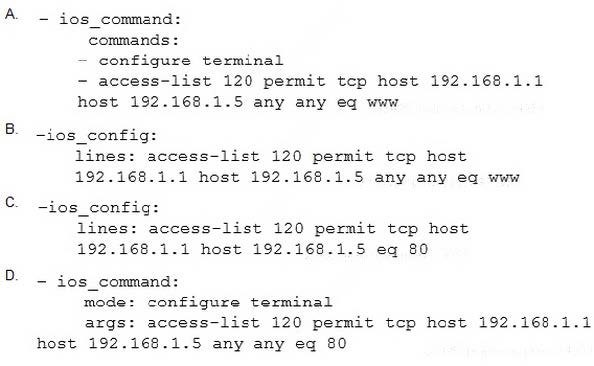Exam Details
Exam Code
:200-901Exam Name
:Developing Applications and Automating Workflows using Cisco Platforms (DEVASC)Certification
:Cisco Certified DevNet AssociateVendor
:CiscoTotal Questions
:615 Q&AsLast Updated
:Jun 19, 2025
Cisco Cisco Certified DevNet Associate 200-901 Questions & Answers
-
Question 41:
Refer to the exhibit.

A developer created a Python script by using the Cisco Meraki API. The solution must:
1.
Obtain a list of HTTP servers for a network named “net1”.
2.
Print the response body if the HTTP status code is 200.
3.
Handle the timeout requests as exceptions, and print Timeout Error next to the exception to stdout.
Which block of code completes the script?

A. Option A
B. Option B
C. Option C
D. Option D
-
Question 42:
Why should a code review process be used?
A. It enables various software design implementations.
B. It enables a consistent software design.
C. It ensures that members of a team work in isolation.
D. It ensures that whole software is secure.
-
Question 43:
An engineer is responsible for several thousand network devices across many campus environments that are all connected to a common controller. Which action updates all devices with new security settings in this network?
A. Get a list of all devices from the controller and use a CLI to change the settings on individual devices.
B. Track a list of all devices on a spreadsheet and use a CLI to change the settings on individual devices.
C. Get a list of all devices from the controller and use RESTCONF to set a YANG model on the devices.
D. Track a list of all devices on a spreadsheet and use RESTCONF to set a YANG model on the devices.
-
Question 44:
Refer to the exhibit.

A Cisco Meraki network was recently installed. Which TCP port is used to gain access to the Meraki dashboard to complete the configuration?
A. 22
B. 23
C. 443
D. 8080
-
Question 45:
A developer must add an idempotent task to an Ansible playbook that configures a Cisco IOS device. HTTP traffic must be permitted from 192.168.1.1 to 192.168.1.5 host machine. Which code snippet must be used?

A. Option A
B. Option B
C. Option C
D. Option D
-
Question 46:
Refer to the exhibit.

An engineer is creating a Dockerfile for an application to run on a container. Application is a web application build on the Python Flask framework. Which port of the Dockerfile provides desired reachability to the application from the outside of the container?
A. RUN pip3 install Flask
B. MAINTAINER User One ([email protected])
C. EXPOSE 80
D. COPY ./app
-
Question 47:
How does a synchronous API request differ from an asynchronous API request?
A. clients are able to access the results immediately
B. clients subscribe to a webhook for operation results
C. clients poll for the status of the execution of operations
D. clients receive responses with a task ID for further processing
-
Question 48:
Refer to the exhibit.

What is the result of running the Dockerfile?
A. Copy the directory /app from the ubuntu:18.04 image, build it with make, and execute the application with the Python command.
B. Copy the directory app from the current directory of the Docker client, execute the application with make, and after it runs, execute an additional application.
C. Copy the directory app from the current directory of the Docker client, build it with make, and execute the application with the Python command.
D. Copy the /app directory from the ubuntu:18.04 image, execute the application with make, and after it runs, execute an additional application.
-
Question 49:
A developer is working on an existing feature that needs enhancing. The primary production branch for the application is ‘prim4a3b8c6d80374’ and the branch for working on the feature is ‘feat145678909’. The developer needs to create a clone of the single branch used for the feature that only has commits included in the current line of history. Which Git command must be used?
A. git clone [url] - -feat145678909 - -single-branch
B. git clone [url] - -branch feat145678909 - -single
C. git clone [url] - -single-branch feat145678909
D. git clone [url] - -branch feat145678909 - -single-branch
-
Question 50:
What is a difference between device-level and controller-level infrastructure management?
A. Device-level management uses NETCONF, whereas controller-level management does not support NETCONF to automate the infrastructure.
B. Controller-level management uses APIs to simplify the developer experience, whereas device-level management uses traditional management protocols.
C. Controller-level management is more widely supported because it is standards-based, whereas device-level management is proprietary to each vendor.
D. Controller-level management exposes northbound, southbound, eastbound, and westbound APIs, easing integration with other technologies, whereas device-level management does not use a controller-based API.
Tips on How to Prepare for the Exams
Nowadays, the certification exams become more and more important and required by more and more enterprises when applying for a job. But how to prepare for the exam effectively? How to prepare for the exam in a short time with less efforts? How to get a ideal result and how to find the most reliable resources? Here on Vcedump.com, you will find all the answers. Vcedump.com provide not only Cisco exam questions, answers and explanations but also complete assistance on your exam preparation and certification application. If you are confused on your 200-901 exam preparations and Cisco certification application, do not hesitate to visit our Vcedump.com to find your solutions here.